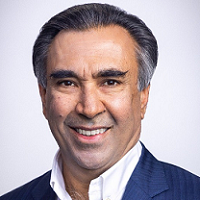
Kevin Chaney, M.G.S., Senior Advisor for Dissemination and Innovation in AHRQ’s Digital Healthcare Research Division
LinkedIn: Kevin Chaney
LinkedIn: AHRQ
Sanjeev Arora, M.D., F.A.C.G., a former AHRQ grantee, distinguished and regents professor of medicine and founder and director of Project ECHO
LinkedIn: Dr. Sanjeev Arora

AHRQ’s Digital Healthcare Research Program, which this year commemorates its 20th anniversary, has consistently encouraged the adoption of technologies to enhance not only healthcare quality and safety, but access too. Today we’d like to tell you about AHRQ’s instrumental role in building the foundation for telehealthcare.
Telehealthcare, the use of electronic information and telecommunication technologies to provide healthcare at a distance, has become an integral component of U.S. healthcare. It is critical to delivering care in underserved areas and in locations where specialized expertise is limited. AHRQ didn’t invent telehealthcare, but the agency was deeply involved in shaping it into its modern form.
The notion that healthcare could be delivered remotely is nearly as old as the telephone itself (PDF, 2.5 MB). NASA employed an early iteration in the 1960s to monitor the physical condition of astronauts in flight. By the 1990s, the concept became regarded as inevitable, even routine. However, its widespread adoption was hindered by a problem: healthcare information systems that needed to share data usually couldn’t “talk” to each other, especially across vast distances where information standards differed.
This is where AHRQ made its first big difference in advancing telehealthcare: health information exchange, the process by which clinical providers and patients can access and securely share medical data electronically. Starting in 2004, AHRQ’s Division of Health Information Technology—the precursor to the Digital Healthcare Research Program—funded six states to identify and support data sharing and interoperability activities (PDF, 2.4 MB). (The exchanges that developed have since given way to Qualified Health Information Networks, which are networks of organizations that safely and seamlessly share health-related data and are administered by the Assistant Secretary for Technology Policy and Office of the National Coordinator for Health Information Technology.
This work allowed AHRQ to lay the figurative cable for telehealthcare. An initial $1.4 million grant in 2004 led to the widespread adoption of Project ECHO, an early telementoring model that connects frontline health workers in underserved communities with experts. ECHO combines technology and a trusted human network to support for healthcare workers.
Originally developed to give rural patients with Hepatitis C access to treatments similar to what they might receive at an academic medical center, Project ECHO demonstrated that telehealthcare could succeed on a broad scale. This initial funding led to the publication of a study showing that ECHO-trained clinicians had the same, and sometimes better, outcomes for their Hepatitis C patients than university experts.
ECHO proved wildly successful and remains the model on which a significant amount of telehealthcare is based. ECHO programs now address more than 70 disease areas, with participants in all 50 states and in more than 200 countries. More than 450 U.S. academic and medical centers have adopted the ECHO model. More than 600 peer-reviewed studies have affirmed its effectiveness.
When COVID-19 emerged in 2020, ECHO became a central aspect of the federal government’s response. The AHRQ ECHO National Nursing Home COVID-19 Action Network – a partnership among AHRQ, the University of New Mexico’s ECHO Institute, and the Institute for Healthcare Improvement – provided free training to nursing homes nationwide to encourage implementation of evidence-based infection prevention and safety practices to protect residents and staff. Staff from more than 9,000 nursing homes participated in more than 7,000 training sessions.
Today, telehealthcare has expanded beyond teleconsultation to include secure messaging, electronic prescribing, remote monitoring, disease management, and remote physical, mental, and behavioral therapy. Recent AHRQ-funded projects supporting telehealthcare include:
- Guides and toolkits to help providers integrate patient-generated health data and patient-reported outcomes (PROs) into clinical care
- Research to bolster a telehealth lung cancer surveillance program that combines PROs and assessments of remotely completed surveillance lung imaging
- A virtual in-home program designed to reduce hospital readmissions among COPD patients
- A project to implement and test school-based telephysiatry services for children living in rural and underserved communities
- Roadmaps for integrating telehealthcare in emergency medicine and novel approaches to care coordination across emergency medicine services and hospital teams.
As with many aspects of healthcare technology, artificial intelligence (AI) will likely be at the forefront for the foreseeable future, and the Digital Healthcare Research Program is poised to advance telehealthcare in this area. For example, one AHRQ-funded project employed automated speech recognition and automated machine translation technologies integrated in a telepsychiatry application for patients with limited English proficiency.
There is cautious, early optimism that telehealthcare can use AI to help fill provider gaps and shortages in underserved communities. Our vision is that AI-powered telehealthcare will continue to expand access and deliver personalized, high-quality, safe healthcare to all Americans, regardless of where they live. We’re excited to explore and bring insights into the application and utility of these groundbreaking technologies.
At this 20th anniversary, AHRQ’s Digital Healthcare Research Program continues to forge new and promising research for telehealthcare. We can’t wait to see where it leads.
This article was originally published on AHRQ Views Blog and is republished here with permission.
